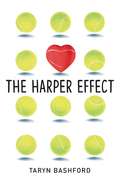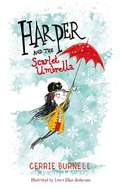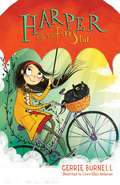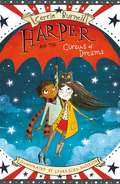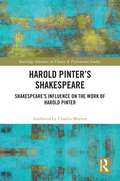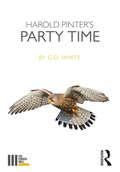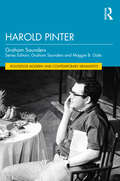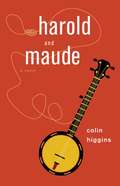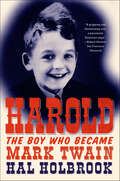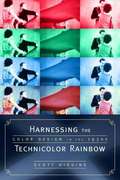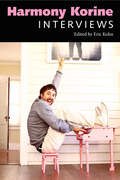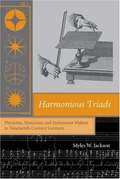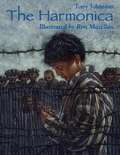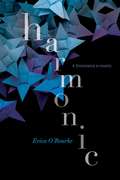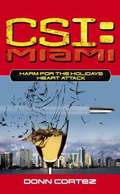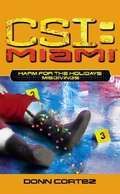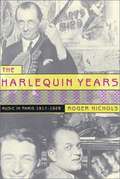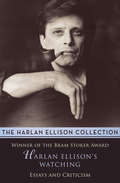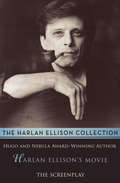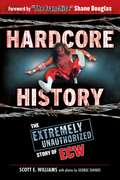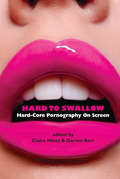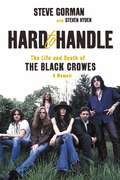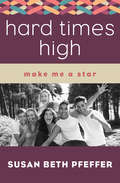- Table View
- List View
The Harper Effect
by Taryn BashfordA sizzling coming of age story set in the world of professional tennis about a girl who learns to win from a boy who has lost everything. Sixteen-year-old Harper was once a rising star on the tennis court—until her coach dropped her for being “mentally weak.” Without tennis, who is she? Her confidence at an all-time low, she secretly turns to her childhood friend, next-door neighbor Jacob—who also happens to be her sister’s very recent ex-boyfriend. If her sister finds out, it will mean a family war. But when Harper is taken on by a new coach who wants her to train with Colt, a cold, defensive, brooding young tennis phenom, she hits the court all the harder, if only to prove to Colt she has it in her to be a champion. As the two learn to become a team, Harper gets glimpses of the vulnerable boy beneath the surface, the boy who was deeply scarred by his family’s dark and scandalous past. The boy she could easily find herself falling for. As she walks a fine line between Colt’s secrets, her forbidden love, and a game that demands nothing but the best, Harper must choose between her past and her future and between two boys who send her head spinning. Turns out, the biggest battle she needs to win, is the one against herself.
Harper and the Scarlet Umbrella (Harper Ser. #1)
by Laura Ellen Anderson Cerrie BurnellOnce there was a girl named Harper who had a rare musical gift. She heard songs on the wind, rhythms on the rain, and hope in the beat of a butterfly’s wing.Harper lives in the City of Clouds, an enchanting place where it rains every day and an umbrella is always a good idea. With her Aunt Sassy, her beloved cat, Midnight, and all of her neighbors in the Tall Apartment Block, every day is full of possibility.But when every cat in the city goes missing-including Midnight-Harper is determined to find all of the precious pets. And she’ll need a magic, flying umbrella to help in her search. Recruiting friends from her building to help, the magic umbrella whisks them into the sky on the trail of the cats and adventure.They stumble on the Midnight Orchestra-tabbies on triangle, Siamese singing, Persians on piccolo-all under the direction of its fearsome, wild conductor. But can the group use their talents, quick thinking, musical skill, and a little magic to stage a rescue like no other?Harper and the Scarlet Umbrella is a spellbinding tale of friendship, music, and magic featuring a diverse cast, brought to life through stunning illustrations. A perfect book to be shared and treasured.
Harper and the Fire Star (Harper #4)
by Cerrie Burnell Laura Ellen AndersonHarper and her friends want to help the Wild Conductor win back his place in the magical Circus of Dreams. They put on a wondrous show, but their plan goes horribly wrong. Instead of the Wild Conductor, the ringmaster selects Harper to show off her incredible musical skills for the world to see. But once inside the circus, Harper learns of the Fire Star, a girl with her own extraordinary gift. She shines like a star whenever she hears music. And Harper may have figured out why . . .
Harper and the Circus of Dreams
by Cerrie Burnell Laura AndersonLate one evening as the stars begin to twinkle, Harper and her friends are flying on the scarlet umbrella when they see a girl running on air, skipping along a tightrope. She leads them to the Circus of Dreams, suspended in the air by hot air balloons. There, they meet the mermaid acrobat, the spectacular circus baker, the mysterious fortune teller and the acrobatics troupe, all more spectacular than one could dream.But as they learn more about the Circus of Dreams, Harper learns a secret about her past that is more than magic. . . .Harper and the Circus of Dreams continues the adventures of Harper and her friends in a magical mystery like no other. An enchanting story of friendship, music, and magic featuring a diverse cast, brought to life through stunning illustrations, this is a book to be shared and treasured.
Harold's Circus
by Crockett Johnson"One moonlit evening, mainly to prove to himself he could do it, Harold went for a walk on a tightrope. He made sure the rope was drawn tight and straight, so it wouldn't sway. He skipped lightly across it, finding it fun to be a tightrope walker, high up over the rest of the circus. He stayed up on the rope with the greatest of ease, until he lost his balance. It also is easy to fall off a tightrope. Harold fell, twisting and turning, with his purple crayon tight in his hand. By a stroke of luck, a comfortable-looking curve appeared beneath him. And he landed on ..." "An Astounding Colossal, Purple Crayon Event!" Charming and fun.
Harold Pinter's Shakespeare: Shakespeare's Influence on the Work of Harold Pinter (Routledge Advances in Theatre & Performance Studies)
by Charles MortonThis book charts the impact of Shakespeare’s works on Harold Pinter’s career as a playwright. This exploration traces Shakespeare’s influence through Pinter’s pre-theatre writings (1950-1956), to his collaboration with Sir Peter Hall (starting properly at the RSC in 1962 and continuing until 1983), and a late, unpublished screenplay for an adaptation of The Tragedy of King Lear (2000). Adding to studies of playwrights such as Samuel Beckett and James Joyce as significant influences on Harold Pinter’s work, this study aims to highlight the significant and lasting impact that Shakespeare had both formatively and performatively on the playwright’s career. Through exploring this influence, Morton gains not only a greater understanding of the shaping of Pinter’s artistic outlook and how this affected his writing, but it also sheds light on the various forms of Shakespeare’s continued influence on new writing, and what can be gained from this. This study will be of great interest to students and scholars in theatre and performance studies.
Harold Pinter's Party Time (The Fourth Wall)
by White G. D.‘All you have do is shut up and enjoy the hospitality.’ Terry Harold Pinter’s Party Time (1991) is an extraordinary distillation of the playwright’s key concerns. Pulsing with political anger, it marks a stepping stone on Pinter’s path from iconic dramatist of existential unease to Nobel Prize-winning poet of human rights. <P><P> G. D. White situates this underrated play within a recognisably ‘Pinteresque’ landscape of ambiguous, brittle social drama while also recognising its particularity: Party Time is haunted by Augusto Pinochet’s right-wing coup against Salvador Allende’s democratically elected government in Chile. <P><P> This book considers Party Time and its confederate plays in the dual context of Pinter’s literary career and burgeoning international concern with human rights and freedom of expression, contrasting his uneasy relationship with the UK’s powerful elite with the worldwide acclaim for his dramatic eviscerations of power.
Harold Pinter (Routledge Modern and Contemporary Dramatists)
by Graham SaundersHarold Pinter provides an up-to-date analysis and reappraisal concerning the work of one of the most studied and performed dramatists in the world. Drawing extensively from The Harold Pinter Archive at the British Library as well as reviews and other critical materials, this book offers new insights into previously established views about his work. The book also analyses and reappraises specific key historical and contemporary productions, including a selection of Pinter’s most significant screenplays. In particular, this volume seeks to assess Pinter’s critical reputation and legacy since his death in 2008. These include his position as a political writer and political activist – from disassociation and neutrality on the subject until relatively late in his career when his drama sought to explicitly address questions of political dissent and torture by totalitarian regimes. The book revisits some familiar territories such as Pinter’s place as a British absurdist and the role memory plays in his work, but it also sets out to explore new territories such as Pinter’s changing attitudes towards gender in the light of #MeToo and queer politics and how in particular a play such as The Caretaker (1960) through several key productions has brought the issues of race into sharper focus. Part of the Routledge Modern and Contemporary Dramatist series, Harold Pinter provides an essential and accessible guide to the dramatists’ work.
Harold and Maude
by Colin HigginsNineteen-year-old Harold Chasen is obsessed with death. He fakes suicides to shock his self-obsessed mother, drives a hearse, and attends funerals of complete strangers. Seventy-nine-year-old Maude Chardin, on the other hand, adores life. She liberates trees from city sidewalks and transplants them to the forest, paints smiles on the faces of church statues, and "borrows" cars to remind their owners that life is fleeting-- here today, gone tomorrow! A chance meeting between the two turns into a madcap, whirlwind romance, and Harold learns that life is worth living, and how to play the banjo. Harold and Maude started as Colin Higgins's master's thesis at UCLA film school before being made into the 1971 film directed by Hal Ashby. The quirky, dark comedy gained a loyal cult following, and in 1997 it was selected for inclusion on the National Film Registry at the Library of Congress. Higgins's novelization was released with the original film but has been out of print for more than thirty years. Fans who have seen the movie dozens of times will find this a valuable companion, as it gives fresh elements to watch for and answers many of the film's unresolved questions.
Harold: The Boy Who Became Mark Twain
by Hal HolbrookIn Harold: The Boy Who Became Mark Twain, the beloved stage, film, and television actor Hal Holbrook presents an affecting memoir about his struggle to discover his true self, even as he learned to transform himself onstage.Abandoned by his mother and father when he was two, Holbrook and his two sisters commenced separate journeys of survival. Raised by his powerful grandfather, who died when Holbrook was twelve, he spent his childhood at boarding schools, visiting his father in an insane asylum and hoping his mother would suddenly surface in Hollywood.As World War II engulfed Europe, Holbrook began acting almost by accident. Through war, marriage, and the work of honing his craft, his fear of insanity and his fearlessness in the face of risk were channeled into discovering that the riskiest path of all—success as an actor—would be his birthright. The climb up that forbidding mountain was a lonely one. And how he achieved it—the cost to his wife and children and to his own conscience—is the dark side of the fame he would eventually earn by portraying the man his career would forever be most closely associated with: Mark Twain.“If I were to conjure an image of an individual who best fits the phrase ‘a real American,’ it would be Hal Holbrook. This book shows him as a complete person. You will be compelled by the wit and wisdom of this beautifully composed story of self-determination and survival.”—Robert Redford
Harnessing the Technicolor Rainbow: Color Design in the 1930s
by Scott HigginsLike Dorothy waking up over the rainbow in the Land of Oz, Hollywood discovered a vivid new world of color in the 1930s. The introduction of three-color Technicolor technology in 1932 gave filmmakers a powerful tool with which to guide viewers' attention, punctuate turning points, and express emotional subtext. Although many producers and filmmakers initially resisted the use of color, Technicolor designers, led by the legendary Natalie Kalmus, developed an aesthetic that complemented the classical Hollywood filmmaking style while still offering innovative novelty. By the end of the 1930s, color in film was thoroughly harnessed to narrative, and it became elegantly expressive without threatening the coherence of the film's imaginary world.
Harmony Korine: Interviews (Conversations with Filmmakers Series)
by Eric KohnHarmony Korine: Interviews tracks filmmaker Korine's stunning rise, fall, and rise again through his own evolving voice. Bringing together interviews collected from over two decades, this unique chronicle includes rare interviews unavailable in print for years and an extensive, new conversation recorded at the filmmaker's home in Nashville.After more than twenty years, Harmony Korine (b. 1973) remains one of the most prominent and yet subversive filmmakers in America. Ever since his entry into the independent film scene as the irrepressible prodigy who wrote the screenplay for Larry Clark's Kids in 1992, Korine has retained his stature as the ultimate cinematic provocateur. He both intelligently observes modern social milieus and simultaneously thumbs his nose at them. Now approaching middle age, and more influential than ever, Korine remains intentionally sensationalistic and ceaselessly creative.He parlayed the success of Kids into directing the dreamy portrait of neglect, Gummo, two years later. With his audacious 1999 digital video drama Julien Donkey-Boy, Korine continued to demonstrate a penchant for fusing experimental, subversive interests with lyrical narrative techniques. Surviving an early career burnout, he resurfaced with a trifecta of insightful works that built on his earlier aesthetic leanings: a surprisingly delicate rumination on identity (Mister Lonely), a gritty quasi-diary film (Trash Humpers), and a blistering portrait of American hedonism (Spring Breakers), which yielded significant commercial success. Throughout his career he has also continued as a mixed-media artist whose fields included music videos, paintings, photography, publishing, songwriting, and performance art.
Harmonious Triads: Physicists, Musicians, and Instrument Makers in Nineteenth-Century Germany
by Myles W. JacksonJackson analyzes the relationship of physicists, musicians, and instrument makers in Germany. Musical instruments provided physicists with experimental systems, and physicists' research led directly to improvements in musical-instrument manufacture and assisted musicians.
The Harmonica
by Tony Johnston Ron MazellanWhen the Nazis invaded Poland, a family is split apart. The parents are sent to one concentration camp, their son to another. Only his father's gift, a harmonica, keeps the boy's hopes alive and, miraculously, ensures his survival. Tony Johnston's powerf
Harmonic
by Erica O'RourkeDel's older sister can also walk between worlds, but her loyalties are uniquely tested in this original enovella set in the inventive world of Dissonance.Addison Sullivan, Del's older sister, has always been considered a model Walker--but her reputation within the Consort has been tainted by her grandfather's betrayal and her sister's recklessness. She is desperate to regain her position within the Consort and equally desperate to keep Del from spiraling out of control after losing the boy she loves. The Consort offers Addie a chance to redeem herself: if she can track down the Free Walkers her grandfather knew twenty years ago, they'll fast-track her apprenticeship and put her in charge of her own team. Addie asks a former classmate and crush, Laurel, a Consort historian, for help. As they work together, Addie's feelings for Laurel resurface, but she's too afraid to act. Same-sex relationships aren't expressly forbidden by the Consort, but she fears that a relationship with Laurel would be viewed as yet another mark against her. While she is fighting her feelings for Laurel, troubling details start emerging during their investigation...details that paint Addie's family in a sinister light. Will she reveal what she's learned to the Consort, or try to protect her family? This enovella is set in the time between Dissonance and Resonance.
Harm For the Holidays, Part Two: Miami)
by Donn CortezAs winter's hold deepens in the dark days of February, Miami's hotels fill to the bursting point. Cruise ships flock to the busiest port in the world as people desperate for warmer climates board these behemoths of the seas. People with too much time and money fill the clubs. In every other jurisdiction, as its citizens are driven indoors, there is a downturn in crime but not in Miami, as the members of the Miami-Dade Crime Lab can attest. Stretched to the breaking point, Lieutenant Caine is called to what appears to be a failed international terrorist incident: a botched arms-for-Afghani-heroin exchange. The scene is littered with bodies and blood droplets identified as being from one Abdus Sattar Pathan. Once before, Pathan managed to escape being charged in the murder of a Federal agent. This time Caine has him. Except Pathan has an iron-clad alibi: he was miles away, on stage doing his magic act. Horatio is convinced that Pathan and the international terrorist known as the Hare are one and the same. Can Caine prove it before the Hare puts his deadly plan into motion?
Harm for the Holidays, Part One: Miami)
by Donn CortezChristmas in Miami-the city is wrapped in its own unique festive cheer, and countless children breathlessly await the arrival of Santa Claus. Except this year there are hundreds of Santas. Miami has been invaded by the Red Menace. An annual gathering of hundreds of red-suited, jolly old fat men and women swarm over the city, comical and annoying, until one of them turns up dead. In what should be a time of goodwill to all the Miami-Dade Crime Lab finds that what appears to be the simplest of crimes hides darker motives. Who would want to kill Santa? Who would go to such lengths to conceal the identity of a victim that they would decapitate him and remove both his hands? And how does a simple convenience store robbery suddenly spiral into an international incident of kidnapping and murder?
The Harlequin Years: Music in Paris 1917-1929
by Roger NicholsA highly readable study of the music scene in Paris after WWI through the 1920s, including classical and popular music, theatre, dance, and the opera.
Harlan Ellison's Watching: Essays and Criticism
by Harlan EllisonOstensibly, this is a collection of Harlan Ellison's twenty-five years of essays and film criticism for various publications. What it is in reality is pure, raw, unapologetic opinion. Star Wars? "Luke Skywalker is a nerd and Darth Vader sucks runny eggs." Big Trouble in Little China? "A cheerfully blathering live-action cartoon that will give you release from the real pressures of your basically dreary lives." Despite working within the industry himself, Ellison never learned how to lie. So punches go un-pulled, the impersonal becomes personal, and the reader is left feeling like they have read something someone actually meant. It is a gauntlet, for sure, but it is also an exhilarating release.
Harlan Ellison's Movie: The Screenplay
by Harlan EllisonHerein lies in written form Harlan Ellison's Movie, the full-length feature film Ellison created when a producer at 20th Century-Fox said, "If we gave you the money, and no interference, what sort of movie would you write?" Well, that producer is no longer at the studio; he left the entire venue of moviemaking after Harlan Ellison's Movie was seen by the Suits. There is no use even trying to describe what the film is about, except to confirm the long-standing rumor that it contains a scene in which a 70-foot-tall boll weevil chews and swallows an entire farmhouse and silo on-camera. (It is Scene 33C.)
Hardcore History: The Extremely Unauthorized Story of ECW
by Scott E. Williams Shane Douglas George TahinosExtreme Championship Wrestling (ECW) was one extreme contradiction on top of another. An incredibly influential-but never profitable-company in the world of professional wrestling in the 1990s, it portrayed itself as the ultimate in anti-authority rebellion, but its leadership was working covertly with the World Wrestling Federation and the World Championship Wrestling. Most of all, it blurred the line between reality and the fantasy world of professional wrestling.Hardcore History: The Extremely Unauthorized Story of ECW offers a frank, balanced look at the evolution of ECW starting before its early days as a Philadelphia-area independent group and extending past its death in 2001. Featuring dozens of interviews with fans, officials, business partners, and the wrestlers themselves, this is a very balanced account of this bizarre company-and it’s sure to be extremely controversial for fans and critics of ECW, and wrestling, alike.Skyhorse Publishing, as well as our Sports Publishing imprint, is proud to publish a broad range of books for readers interested in sports-books about baseball, pro football, college football, pro and college basketball, hockey, or soccer, we have a book about your sport or your team.In addition to books on popular team sports, we also publish books for a wide variety of athletes and sports enthusiasts, including books on running, cycling, horseback riding, swimming, tennis, martial arts, golf, camping, hiking, aviation, boating, and so much more. While not every title we publish becomes a New York Times bestseller or a national bestseller, we are committed to publishing books on subjects that are sometimes overlooked by other publishers and to authors whose work might not otherwise find a home.
Hard to Swallow: Hard-Core Pornography on Screen
by Hines Claire Darren KerrEven in our increasingly sexualized culture hard-core pornography and the representation of explicit sex is still hard to swallow. This lively and provocative new collection of essays by leading scholars explores screen representations of pornography and sex in a variety of cultural, historical, and critical contexts. Contributions cover a wide range of topics from sex in the multiplex to online alt-porn, from women in stag films to the excesses of extreme pornography, and a variety of contemporary case studies including porn performance, fashion in hard-core, and gay and lesbian pornography.
Hard to Swallow: Hard-Core Pornography on Screen
by Claire Hines Darren KerrEven in our increasingly sexualized culture hard-core pornography and the representation of explicit sex is still hard to swallow. This lively and provocative new collection of essays by leading scholars explores screen representations of pornography and sex in a variety of cultural, historical, and critical contexts. Contributions cover a wide range of topics from sex in the multiplex to online alt-porn, from women in stag films to the excesses of extreme pornography, and a variety of contemporary case studies including porn performance, fashion in hard-core, and gay and lesbian pornography.
Hard to Handle: The Life and Death of the Black Crowes--A Memoir
by Steve GormanAn insider biography of the Black Crowes by drummer and cofounder Steve GormanFor over two decades, The Black Crowes topped the charts and reigned supreme over the radio waves, even as hair bands, grunge, and hip-hop threatened to dethrone them. With hits like "Hard to Handle," "She Talks to Angels," and "Remedy," their massive success launched them to stardom in the early '90s, earning them a place among rock royalty. They were on the cover of Rolling Stone, MTV played their videos 24/7, and Generation X re-discovered the power of classic rock and blues by digging into multi-platinum classics like Shake Your Money Maker and The Southern Harmony and Musical Companion. But stardom can be fleeting. For the Black Crowes, success slowly dwindled as the band members got caught up in the rock star world and lost sight of their musical ambition. Despite the drinking, drugs, and incessant fighting between Chris and Rich Robinson--the angriest brothers in rock and roll, with all due respect to Oasis and the Kinks--the band continued to tour until 2013. On any given night, they could be the best band you ever saw. (Or the most combative.) Then, one last rift caused by Chris Robinson proved insurmountable for the band to survive. After that, the Black Crowes would fly no more. Founding member Steve Gorman was there for all of it--the coke and weed-fueled tours; the tumultuous recording sessions; the backstage hangs with legends like Robert Plant, Jimmy Page, and the Rolling Stones. As the band's drummer and voice of reason, he tried to keep the Black Crowes together musically--and in one piece emotionally. In his first-person history of the Black Crowes, Hard To Handle--the first ever account of this great American rock band's beginning, middle, and end--Gorman makes it clear just how impossible that job was. Fortunately, Gorman tells the tale with great insight, candor, and humor. They don't make bands like the Black Crowes anymore: crazy, brilliant, self-destructive, inspiring, and, ultimately, not built to last. But, man, what a ride it was while it lasted.
Hard Times High (Make Me a Star #6)
by Susan Beth PfefferA cast member of TV's number-one show is about to be fired--how will Alison, Bill, TJ, Rafe, Molly, Miranda, and Susie handle the possibility of being unemployed? A bombshell has just been dropped on the cast of TV's Hard Time High: A major new storyline is being introduced. But it means someone is going to get canned from the show. Former childhood star TJ has lived through this before, when his previous hit TV show was canceled. Used to the steady paycheck after a life on the road, Molly makes a list of her options. Left with a mountain of debt if he gets axed, Rafe's only hope is the movie he just filmed. If ex-teen beauty queen Alison loses her job, how will she go on supporting her family? After years of commercials and made-for-TV movies, Bill doesn't want to lose his chance at a real career. Miranda can't imagine being let go when she's still learning the acting ropes. And Susie worries that she was only cast in the first place because she's the producer's daughter. But one of the seven is going to be kicked off the show. The bigger surprise is what will happen next.
